Spring 2016: Igneous and Metamorphic Petrology (Geology 307)
Item set
- Title
- Spring 2016: Igneous and Metamorphic Petrology (Geology 307)
Items
-
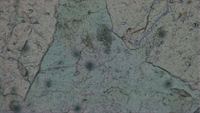 Type: Metamorphic Rock Minerals Present: Garnet, Hornblende, Biotite, Plagioclase Feldspar, Quartz, Potassium Feldspar, Magnetite/ Ilmenite This sample is classified as a granulite, because it shows no clear examples of foliation. The rock can be divided into two separate areas with very different characteristics. In hand sample the color is generally brown. Garnet and hornblende crystals can be seen with the naked eye. The thin section made of this sample captures both areas of the specimen. Both halves are is porphyroblastic, but differ in mineral assemblages. One half contains large porphyroblasts of almadine garnets with many inclusions. The fine-grained minerals surrounding the garnet consist of mostly quartz and potassium feldspars. The garnets have an idioblastic shape, meaning that their crystal faces are well formed. Another prominent mineral seen within the thin section is a black, bladed, opaque mineral, possibly magnetite or Ilmenite. The other half of the hand sample consists of large, elongate hornblende and biotite porphyroblasts surrounded by smaller grains of garnets, plagioclase feldspar, and magnetite/Ilmenite. The hornblende and biotite crystals are all oriented parallel to one another, suggesting foliation. Its possible that this section of the rock is classified as an amphibolite, due to the lineation seen in thin section. How these two facies came to be in such close proximity is a mystery.
Type: Metamorphic Rock Minerals Present: Garnet, Hornblende, Biotite, Plagioclase Feldspar, Quartz, Potassium Feldspar, Magnetite/ Ilmenite This sample is classified as a granulite, because it shows no clear examples of foliation. The rock can be divided into two separate areas with very different characteristics. In hand sample the color is generally brown. Garnet and hornblende crystals can be seen with the naked eye. The thin section made of this sample captures both areas of the specimen. Both halves are is porphyroblastic, but differ in mineral assemblages. One half contains large porphyroblasts of almadine garnets with many inclusions. The fine-grained minerals surrounding the garnet consist of mostly quartz and potassium feldspars. The garnets have an idioblastic shape, meaning that their crystal faces are well formed. Another prominent mineral seen within the thin section is a black, bladed, opaque mineral, possibly magnetite or Ilmenite. The other half of the hand sample consists of large, elongate hornblende and biotite porphyroblasts surrounded by smaller grains of garnets, plagioclase feldspar, and magnetite/Ilmenite. The hornblende and biotite crystals are all oriented parallel to one another, suggesting foliation. Its possible that this section of the rock is classified as an amphibolite, due to the lineation seen in thin section. How these two facies came to be in such close proximity is a mystery. -
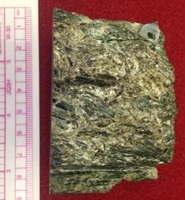 Amphibolite is a medium grade metamorphic rock. Its mineral assemblage includes (unsurprisingly) hornblende, plagioclase, and sometimes garnet. The same displays large, euhedral hornblende crystals and a cracked texture.
Amphibolite is a medium grade metamorphic rock. Its mineral assemblage includes (unsurprisingly) hornblende, plagioclase, and sometimes garnet. The same displays large, euhedral hornblende crystals and a cracked texture. -
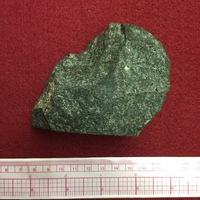 Sample Name: R1892 Identifying Minerals: (1) garnet; (2) chlorite; (3) pyroxene omphacite; (4) quartz Identifying Metamorphic Textures: (a) undulose extinction; (b) poikiloblast; (c) porphyroblast; (d) hypidioblastic; (e) deformation twin; (f) pressure shadow Indication of metamorphic conditions: subduction zone Indication of metamorphic grade: high P – low T
Sample Name: R1892 Identifying Minerals: (1) garnet; (2) chlorite; (3) pyroxene omphacite; (4) quartz Identifying Metamorphic Textures: (a) undulose extinction; (b) poikiloblast; (c) porphyroblast; (d) hypidioblastic; (e) deformation twin; (f) pressure shadow Indication of metamorphic conditions: subduction zone Indication of metamorphic grade: high P – low T -
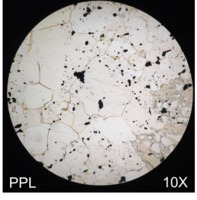 Mineral class: framework silicate Formula: SiO2 Observed Identifying Properties: PPL: (1) no cleavage; (2) Low relief; (3) Color: colorless; (4) Pleochroism: none. XPL: (1) Inclined extinction (35∘) & Undulatory extinction (displayed by deformed quartz); (2) Birefringence color: low-order. Mineral Identification: Hand sample: (1) Habit: crystalline/druse; (2) Cleavage: none; (3) Luster: vitreous; (4) Hardness: 7 PPL: (1) Relief: low positive; (2) Color/Pleochroism: none. XPL: (1) Extinction: inclined extinction (about 35∘); (2) Birefringence: very low, grey/white. Occurrences: “Quartz is a very common mineral found in a wide variey of geological environments. It is abundant in felsic to intermediate intrusive and extrusive igneous rock, and my be found in small amount in volcanic equivalents. In metamorphic rocks it is sbundant in slate, phyllite, schist, gneiss, and quartzite of various types. Because it is stable in the weathering environment, quartz is a major constituent in many clastic sedimentary rocks and may serve as a cementing agent. Hydrothermal vein and replacement deposits typically contain quartz as a gangue mineral, often in the form of crystals, or as microcrystalline and massive varieties.” (Nesse, 2012)
Mineral class: framework silicate Formula: SiO2 Observed Identifying Properties: PPL: (1) no cleavage; (2) Low relief; (3) Color: colorless; (4) Pleochroism: none. XPL: (1) Inclined extinction (35∘) & Undulatory extinction (displayed by deformed quartz); (2) Birefringence color: low-order. Mineral Identification: Hand sample: (1) Habit: crystalline/druse; (2) Cleavage: none; (3) Luster: vitreous; (4) Hardness: 7 PPL: (1) Relief: low positive; (2) Color/Pleochroism: none. XPL: (1) Extinction: inclined extinction (about 35∘); (2) Birefringence: very low, grey/white. Occurrences: “Quartz is a very common mineral found in a wide variey of geological environments. It is abundant in felsic to intermediate intrusive and extrusive igneous rock, and my be found in small amount in volcanic equivalents. In metamorphic rocks it is sbundant in slate, phyllite, schist, gneiss, and quartzite of various types. Because it is stable in the weathering environment, quartz is a major constituent in many clastic sedimentary rocks and may serve as a cementing agent. Hydrothermal vein and replacement deposits typically contain quartz as a gangue mineral, often in the form of crystals, or as microcrystalline and massive varieties.” (Nesse, 2012) -
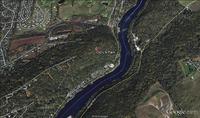 Hand sample is banded, consistent with other Chestnut Hill specimens. Weak cleavage planes run perpendicular to foliation. The banding largely consists of alternating layers of fine to medium grained pale gray and dark gray minerals. Thicker bands of large, white crystals are irregularly spaced within the banding pattern. The bands are wavy, implying compression perpendicular to the banding pattern. Relative visible mineral abundance is as follows: Na-plagioclase (~60%), quartz (~10%), garnet (~2%), muscovite (~1%) Remaining 27% consists of dark colored minerals which are too damaged by weathering to permit identification. Garnet and muscovite crystals are too small to be readily visible to the naked eye. Sample has undergone extensive weathering and diagenesis. A significant portion of the surface is oxidized. Based of the rocks primary composition, it seems likely that the protolith was a diorite or other igneous rock with an intermediate to felsic composition. This is a high grade metamorphic rock.
Hand sample is banded, consistent with other Chestnut Hill specimens. Weak cleavage planes run perpendicular to foliation. The banding largely consists of alternating layers of fine to medium grained pale gray and dark gray minerals. Thicker bands of large, white crystals are irregularly spaced within the banding pattern. The bands are wavy, implying compression perpendicular to the banding pattern. Relative visible mineral abundance is as follows: Na-plagioclase (~60%), quartz (~10%), garnet (~2%), muscovite (~1%) Remaining 27% consists of dark colored minerals which are too damaged by weathering to permit identification. Garnet and muscovite crystals are too small to be readily visible to the naked eye. Sample has undergone extensive weathering and diagenesis. A significant portion of the surface is oxidized. Based of the rocks primary composition, it seems likely that the protolith was a diorite or other igneous rock with an intermediate to felsic composition. This is a high grade metamorphic rock. -
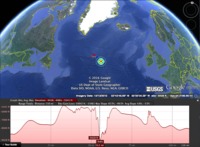
-
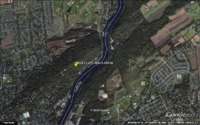 Field photos from Chestnut Hill
Field photos from Chestnut Hill -
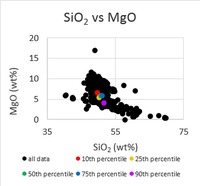
-
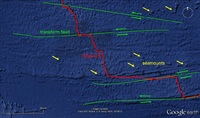 A Google Earth image of a zoomed-in section of the Mid-Atlantic Ridge.
A Google Earth image of a zoomed-in section of the Mid-Atlantic Ridge. -
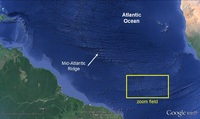 A Google Earth, zoomed out image of the Mid-Atlantic Ridge, with highlighted landforms.
A Google Earth, zoomed out image of the Mid-Atlantic Ridge, with highlighted landforms. -
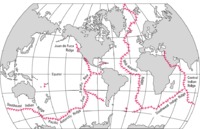 A map of all of the major oceanic spreading centers on Earth
A map of all of the major oceanic spreading centers on Earth -
 image obtained at http://paos.colorado.edu/~toohey/study.html
image obtained at http://paos.colorado.edu/~toohey/study.html -
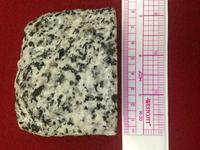 var. tonalite. Sample is phaneritic in texture, and contains many large, eu- and subhedral crystals. Minerals include quartz, feldspars, and biotite. Some intergrowth has occurred.
var. tonalite. Sample is phaneritic in texture, and contains many large, eu- and subhedral crystals. Minerals include quartz, feldspars, and biotite. Some intergrowth has occurred. -
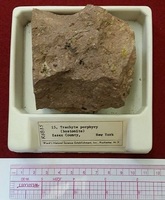 Sample is porphyritic, with a coarse, pink matrix. Phenocrysts are distinctly large and include K-spar, plagioclase, biotite, and muscovite, and represent approximately 15% of the sample by volume. Black microphenocrysts are also present. The sample is of uniform composition.
Sample is porphyritic, with a coarse, pink matrix. Phenocrysts are distinctly large and include K-spar, plagioclase, biotite, and muscovite, and represent approximately 15% of the sample by volume. Black microphenocrysts are also present. The sample is of uniform composition. -
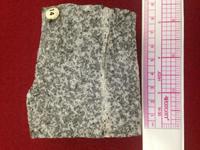 This sample of syenite (var. alkalic syenite) has a phaneritic texture. In hand sample, visible minerals include quartz and Na-rich plagioclase, in roughly equal quantities. Identifying characters include the phaneritic texture and light gray color. In thin section, the quartz and feldspar crystals are intergrown in a matrix, with additional muscovite crystals contributing about 5% by volume. Additional lath-shaped megacrysts are also present, contributing roughly 10% by volume. The crystals show signs of dissolution.
This sample of syenite (var. alkalic syenite) has a phaneritic texture. In hand sample, visible minerals include quartz and Na-rich plagioclase, in roughly equal quantities. Identifying characters include the phaneritic texture and light gray color. In thin section, the quartz and feldspar crystals are intergrown in a matrix, with additional muscovite crystals contributing about 5% by volume. Additional lath-shaped megacrysts are also present, contributing roughly 10% by volume. The crystals show signs of dissolution. -
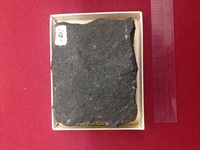 The hand sample is an Aphanitic (fine-grained), dark colored rock with small visible grains of colorless plagioclase and black augite. In he thin section one can see phenocrysts of plagioclase feldspar, augite, and magnetite in a microlite groundmass. The feldspars show some fantastic examples of zoning and twinning. The augite is pleochroic, changing from a yellow to a light-green. Hornblende can be found in thin section with a brown color. The large crystals with inclusions are apatite crystals. This rock initially cooled slowly within a magma chamber, partitioning plagioclase feldspars, augites, and olivines and other mafic minerals, but the more mafic minerals may have sunk to the bottom of the chamber, but as it was cooling the magma heated up again, shown by the oscillatory zoning. Perhaps another, hotter magma was injected into it. After cooling slightly and fractionating, the magma erupted and cooled rapidly.
The hand sample is an Aphanitic (fine-grained), dark colored rock with small visible grains of colorless plagioclase and black augite. In he thin section one can see phenocrysts of plagioclase feldspar, augite, and magnetite in a microlite groundmass. The feldspars show some fantastic examples of zoning and twinning. The augite is pleochroic, changing from a yellow to a light-green. Hornblende can be found in thin section with a brown color. The large crystals with inclusions are apatite crystals. This rock initially cooled slowly within a magma chamber, partitioning plagioclase feldspars, augites, and olivines and other mafic minerals, but the more mafic minerals may have sunk to the bottom of the chamber, but as it was cooling the magma heated up again, shown by the oscillatory zoning. Perhaps another, hotter magma was injected into it. After cooling slightly and fractionating, the magma erupted and cooled rapidly. -
 Hand Sample: This is a overall light-colored rock with many different kinds of crystals embedded in its white matrix. The matrix of the rock is consisted of quartz (40%) and feldspar (20%).Other crystal observed are muscovite (about 15%), biotite (10%) and some amount (10%) of hornblende. Thin Section: This is a holocrystalline rock. 40% of the crystals are quartz(1), we can identify it by its low birefringence color and undulatory extinction. 50% of the crystals are plagioclase(2),because it displays tartan plate and polysynthetic twin.There are also some (10%) muscovite(3) crystals,and its cleavage is somehow bended. There is a small feldspar crystal (4)that displays oscillatory zoning but was embayed. A little (>5%) hornblende(5) is also present. Life History: The rock has been underground,slowly cooling for a long time. It experienced a sudden cooling due to the subduction refrigerator effect. Location: Concord, New Hampshire
Hand Sample: This is a overall light-colored rock with many different kinds of crystals embedded in its white matrix. The matrix of the rock is consisted of quartz (40%) and feldspar (20%).Other crystal observed are muscovite (about 15%), biotite (10%) and some amount (10%) of hornblende. Thin Section: This is a holocrystalline rock. 40% of the crystals are quartz(1), we can identify it by its low birefringence color and undulatory extinction. 50% of the crystals are plagioclase(2),because it displays tartan plate and polysynthetic twin.There are also some (10%) muscovite(3) crystals,and its cleavage is somehow bended. There is a small feldspar crystal (4)that displays oscillatory zoning but was embayed. A little (>5%) hornblende(5) is also present. Life History: The rock has been underground,slowly cooling for a long time. It experienced a sudden cooling due to the subduction refrigerator effect. Location: Concord, New Hampshire -
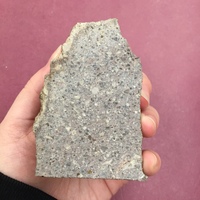 Hand Sample: This is rock contains many small to medium sized diverse crystal with a brick-colored groundmass. 40% of the crystals are white plagioclase, 5%-10% of them are pink alkali feldspar,20% of them are quartz (most of them are medium sized), and 5% of the them are black augite (most of them are in very small pieces). Thin Section: From the thin section we can see a vitrophyric texture. The felty groundmass is consisted of mostly volcanic glass.There are mainly two kinds of phenocrysts. One of them is a xenolith(a).The other type of phenocrysts are equigranular ang also have an embayed texture(b). The phenocrysts (1) are mostly(95%) quartz, because they have a low birefringence color and some display undulatory extinction. (2) maybe a hematite, because of its reddish color in both PPL and XPL. There is only one hematite crystal in this thin section. because it has a very high relief and displays parallel extinction. There are also some(1%-2%) hornblende inclusion in in the quartz phenocryst(3). Life History: This rock cooled slowly undergroud for a while, then it was brought to a new compositional environment, which is why the crystal are dissolving. Location: Unknown
Hand Sample: This is rock contains many small to medium sized diverse crystal with a brick-colored groundmass. 40% of the crystals are white plagioclase, 5%-10% of them are pink alkali feldspar,20% of them are quartz (most of them are medium sized), and 5% of the them are black augite (most of them are in very small pieces). Thin Section: From the thin section we can see a vitrophyric texture. The felty groundmass is consisted of mostly volcanic glass.There are mainly two kinds of phenocrysts. One of them is a xenolith(a).The other type of phenocrysts are equigranular ang also have an embayed texture(b). The phenocrysts (1) are mostly(95%) quartz, because they have a low birefringence color and some display undulatory extinction. (2) maybe a hematite, because of its reddish color in both PPL and XPL. There is only one hematite crystal in this thin section. because it has a very high relief and displays parallel extinction. There are also some(1%-2%) hornblende inclusion in in the quartz phenocryst(3). Life History: This rock cooled slowly undergroud for a while, then it was brought to a new compositional environment, which is why the crystal are dissolving. Location: Unknown -
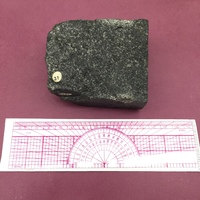 Hand Sample: This is a overall black rock with relatively high density. This rock has a holocrystalline texture. The crystals it contains are mostly black,white and colorless. 60% of them are black hornblende, 30% of them are colorless olivine, and 5-10% of them are white vitreous (probably) feldspar. Thin Section: From the thin section we can see a better holocrystalline texture with only some vesicles (black spots shown in PPL view). Many of the minerals display sieve (or embayed) texture (a).In (b) we can see the crystal consists of many needle-like microlites. In (1) we can see polysynthetic twins, so this is a feldspar (about 35% of all crystals). (2) displays undulatory extinction, which suggests that it is quartz (30%). (3) has a high birefringence color and parallel extinction, so we can say it’s olivine (10%). From its color in PPL (also shows pleochroism) and XPL we can say (4) is hornblende (10%). Life History: This rock didn’t stay for a long time underground before it was blown out by the eruption. The general environment has relatively low pressure and temperature. It maybe experienced compositional change due to magma ejection or experienced the escape of gas. Location:Salem, Massachusetts
Hand Sample: This is a overall black rock with relatively high density. This rock has a holocrystalline texture. The crystals it contains are mostly black,white and colorless. 60% of them are black hornblende, 30% of them are colorless olivine, and 5-10% of them are white vitreous (probably) feldspar. Thin Section: From the thin section we can see a better holocrystalline texture with only some vesicles (black spots shown in PPL view). Many of the minerals display sieve (or embayed) texture (a).In (b) we can see the crystal consists of many needle-like microlites. In (1) we can see polysynthetic twins, so this is a feldspar (about 35% of all crystals). (2) displays undulatory extinction, which suggests that it is quartz (30%). (3) has a high birefringence color and parallel extinction, so we can say it’s olivine (10%). From its color in PPL (also shows pleochroism) and XPL we can say (4) is hornblende (10%). Life History: This rock didn’t stay for a long time underground before it was blown out by the eruption. The general environment has relatively low pressure and temperature. It maybe experienced compositional change due to magma ejection or experienced the escape of gas. Location:Salem, Massachusetts -
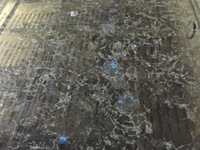 Hand sample: Type: Igneous Rock Prominent mineral: Plagioclase (80%) Typical grain size: Igneous Texture: Chatoyant; Zoning; Thin Section: Mineral: Plagioclase (50%) Alkali feldspar (40%) The colorful part shown in thin section may be the chatoyant texture observed in hand sample. When I was grinding my rock, I might not have cleaned the wheel very well so my rock is scratched, which is the dark lines shown in thin section. When I was grinding my almost-thin section, I grinded it for too long, and half of my rock is gone. Because I grinded the thin section too hard, so some of the holes shown in thin section may not be sieve texture, but the one tan colored mineral may have a sieve texture.
Hand sample: Type: Igneous Rock Prominent mineral: Plagioclase (80%) Typical grain size: Igneous Texture: Chatoyant; Zoning; Thin Section: Mineral: Plagioclase (50%) Alkali feldspar (40%) The colorful part shown in thin section may be the chatoyant texture observed in hand sample. When I was grinding my rock, I might not have cleaned the wheel very well so my rock is scratched, which is the dark lines shown in thin section. When I was grinding my almost-thin section, I grinded it for too long, and half of my rock is gone. Because I grinded the thin section too hard, so some of the holes shown in thin section may not be sieve texture, but the one tan colored mineral may have a sieve texture. -
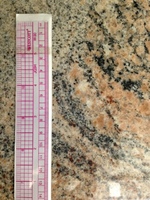 A semi-metamorphosed phaneritic rock. Visible minerals include quartz, K-spar, biotite, etc. Exsolution lamellae are visible in K-spar. Some folding and separation by crystal size is also visible. Crystal size is highly variable.
A semi-metamorphosed phaneritic rock. Visible minerals include quartz, K-spar, biotite, etc. Exsolution lamellae are visible in K-spar. Some folding and separation by crystal size is also visible. Crystal size is highly variable. -
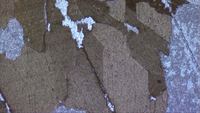 A semi-metamorphosed phaneritic rock. Visible minerals include quartz, K-spar, biotite, etc. Exsolution lamellae are visible in K-spar. Some folding and separation by crystal size is also visible. Crystal size is highly variable.
A semi-metamorphosed phaneritic rock. Visible minerals include quartz, K-spar, biotite, etc. Exsolution lamellae are visible in K-spar. Some folding and separation by crystal size is also visible. Crystal size is highly variable. -
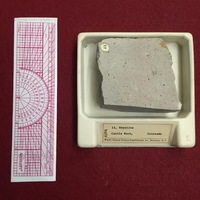 This rock has an overall greyish white color. The matrix is muddy and dull, and it feels somehow gritty in hands. The crystals of the sample are small and vitreous, some of them are colorless and some of them are black. The identifiable minerals are quartz, biotite and muscovite. Rhyolite is an igneous, volcanic, very felsic rock, because it is usually formed in a late crystallization period, when the percentage of Si is pretty high in the magma, because other elements have been moved away through crystallization.
This rock has an overall greyish white color. The matrix is muddy and dull, and it feels somehow gritty in hands. The crystals of the sample are small and vitreous, some of them are colorless and some of them are black. The identifiable minerals are quartz, biotite and muscovite. Rhyolite is an igneous, volcanic, very felsic rock, because it is usually formed in a late crystallization period, when the percentage of Si is pretty high in the magma, because other elements have been moved away through crystallization. -
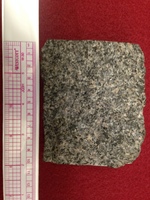 A phaneritic rock of largely felsic composition. Visible minerals include amphiboles, Na-plagioclase and quartz.
A phaneritic rock of largely felsic composition. Visible minerals include amphiboles, Na-plagioclase and quartz. -
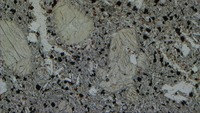 Thin section textures: Porphyritic texture occurs when magma cools slowly and then quickly as it is extruded after starting to cool. This involves a matrix and the presence of crystals in the sample. Phenocrysts are larger crystals set within a fine matrix. In this sample, there are many olivine phenocrysts formed by the magma cooling slowly at first before being extruded. Matrix or groundmass refers to the finer-grained component of this porphyritic sample, which would have cooled quicker than the larger, well-formed crystals. Cumulophyric texture refers to phenocrysts of the same or different minerals, which occur in clusters. This view shows a particular cluster of crystals. Pyroclastic texture refers to a sample comprised of fragments from volcanic activity. This sample contains numerous types of fragments. Microphenocrysts are small crystals that are still larger than the groundmass. They are visible in the fine-grained matrix in this sample. Microlites are tiny needle-like crystals, which have some microscopically detectable properties. They are the tiny needle-like crystals in this sample. Trachytic texture consists of microlites that have been aligned due to the flow of lava.
Thin section textures: Porphyritic texture occurs when magma cools slowly and then quickly as it is extruded after starting to cool. This involves a matrix and the presence of crystals in the sample. Phenocrysts are larger crystals set within a fine matrix. In this sample, there are many olivine phenocrysts formed by the magma cooling slowly at first before being extruded. Matrix or groundmass refers to the finer-grained component of this porphyritic sample, which would have cooled quicker than the larger, well-formed crystals. Cumulophyric texture refers to phenocrysts of the same or different minerals, which occur in clusters. This view shows a particular cluster of crystals. Pyroclastic texture refers to a sample comprised of fragments from volcanic activity. This sample contains numerous types of fragments. Microphenocrysts are small crystals that are still larger than the groundmass. They are visible in the fine-grained matrix in this sample. Microlites are tiny needle-like crystals, which have some microscopically detectable properties. They are the tiny needle-like crystals in this sample. Trachytic texture consists of microlites that have been aligned due to the flow of lava.
